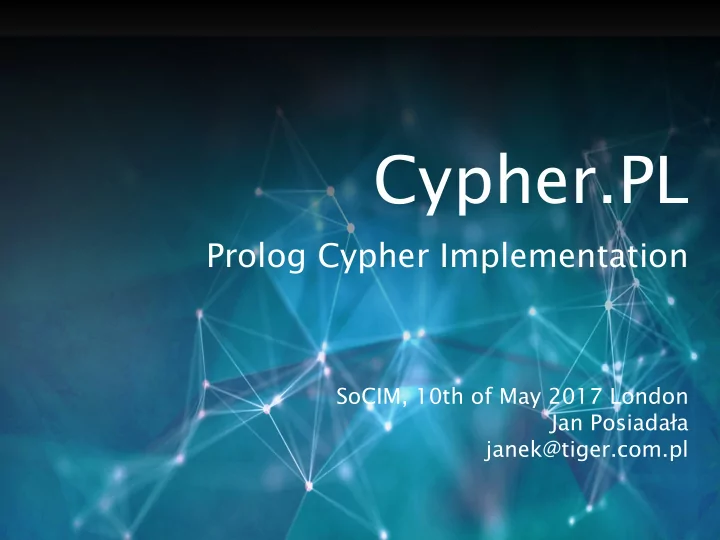

Cypher.PL Prolog Cypher Implementation SoCIM, 10th of May 2017 London Jan Posiadała janek@tiger.com.pl
Prolog Implementation Cypher.PL Cypher implementation in SWI-Prolog: ● formal implementation... ● ...or rather executable specification ● as close to the semantics as possible ● as far from the implementation issues as possible ● tool for designing, verification, validation Cypher.PL SoCIM, 10th of May 2017, London
Why Prolog? Cypher.PL Prolog's enticements: ● built-in unification... ● ...which is more general than pattern matching ● super-native data (structures) representation ● evident ambiguity ● easy constraint verification ● DCG: notation for grammars ● meta-programming Cypher.PL SoCIM, 10th of May 2017, London
openCypher To Cypher.PL Cypher.PL Antlr4ToDCG Cypher Query Cypher Query Cypher Parse Tree Cypher.g4 Grammar in DCG DCG Grammar of Antlr4 Cypher Query Filters, Term Transformations, Representation Scourers Cypher.PL SoCIM, 10th of May 2017, London
Graph Representation Database as facts: node(NodeId). relationship(NodeStartId,RelationshipId,NodeEndId). property(NorRId,Key,Value). %Value = cypherType(RawValue) typeOrLabel(NorRId,TypeOrLabels). % always list Cypher.PL SoCIM, 10th of May 2017, London
Graph Representation Neo4j property graph via Cypher to Prolog facts. match (a)-[r]->(b) return 'relationship(' + id(a) + ',' + id(r) + ',' + id(b) + ').' as fact union match (a) return 'node(' + id(a) + ').' as fact union match (m) unwind keys(m) as key return 'property(' + id(m) + ',\'' + key + '\',\'' + m[key] + '\').' as fact //almost: no type extraction union match ()-[m]->() unwind keys(m) as key return 'property(' + id(m) + ',\'' + key + '\',\'' + m[key] + '\').' as fact //almost: no type extraction union match (m) with reduce(s = "", x IN labels(m) | s + ',\'' + x + '\'') as labels, m as m return 'typeOrLabel(' + id(m) + ',' + substring(labels,1,size(labels) - 1) + ').' as fact union match ()-[m]->() return 'typeOrLabel(' + id(m) + ',[\'' + type(m) + '\']).' as fact Cypher.PL SoCIM, 10th of May 2017, London
Query Intermediate Representation Prolog Term OPTIONAL MATCH (a:Label1:Lablel1 {x:1,y:2})-[r]->(b),(c)-[r:Type*1..7]-(d) WHERE true match( OPTIONAL ,pattern([patternPart(patternElement([nodePattern(variable(symbolicName(a)),nodeLabels([nodeLabe l(labelName(symbolicName( Label1 ))),nodeLabel(labelName(symbolicName( Label2 )))]),properties(mapLiteral([(proper tyKeyName(symoolicName(x)),expression(atom(literal(numberLiteral(1))))), (propertyKeyName(symbolicName(y)),expression(atom(literal(numberLiteral(2)))))]))),relationshipPattern(relatio nshipDetail(variable(symbolicName(r)),relationshipTypes([]),relationshipRange(empty_one_one),properties(mapLit eral([]))),right),nodePattern(variable(symbolicName(b)),nodeLabels([]),properties(mapLiteral([])))])),patternP art(patternElement([nodePattern(variable(symbolicName(c)),nodeLabels([]),properties(mapLiteral([]))),relations hipPattern(relationshipDetail(variable(symbolicName(r)),relationshipTypes([relTypeName(symbolicName( Type ))]),r elationshipRange(1,7),properties(mapLiteral([]))),both),nodePattern(variable(symbolicName(d)),nodeLabels([]),p roperties(mapLiteral([])))]))]),where(expression(atom(literal(booleanLiteral( TRUE )))))) Machine-oriented version Planner-friendly ○ Verbose ○ Minimal ordering constraints ○ Explicit ○ Unique variable names ○ Unambiguous * orange is stolen from Stefan's FoCIM slides Cypher.PL SoCIM, 10th of May 2017, London
Recommend
More recommend